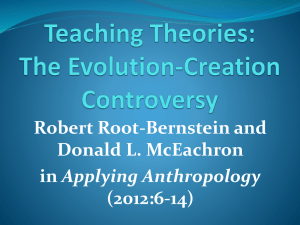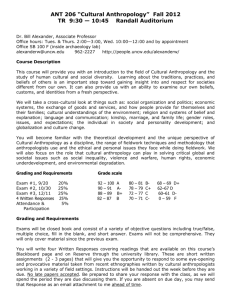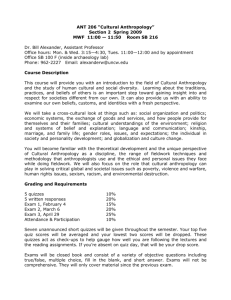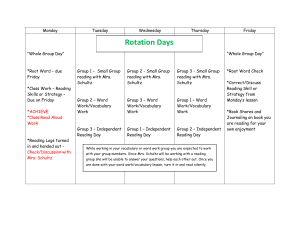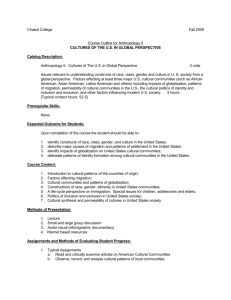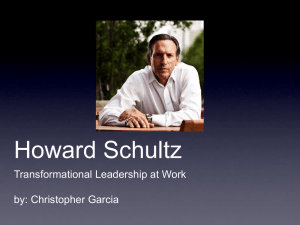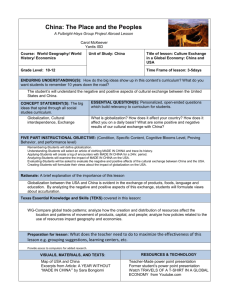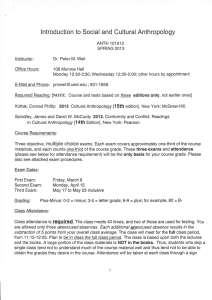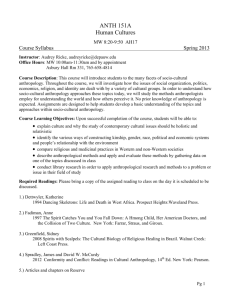Anthropology 100 F`05
advertisement
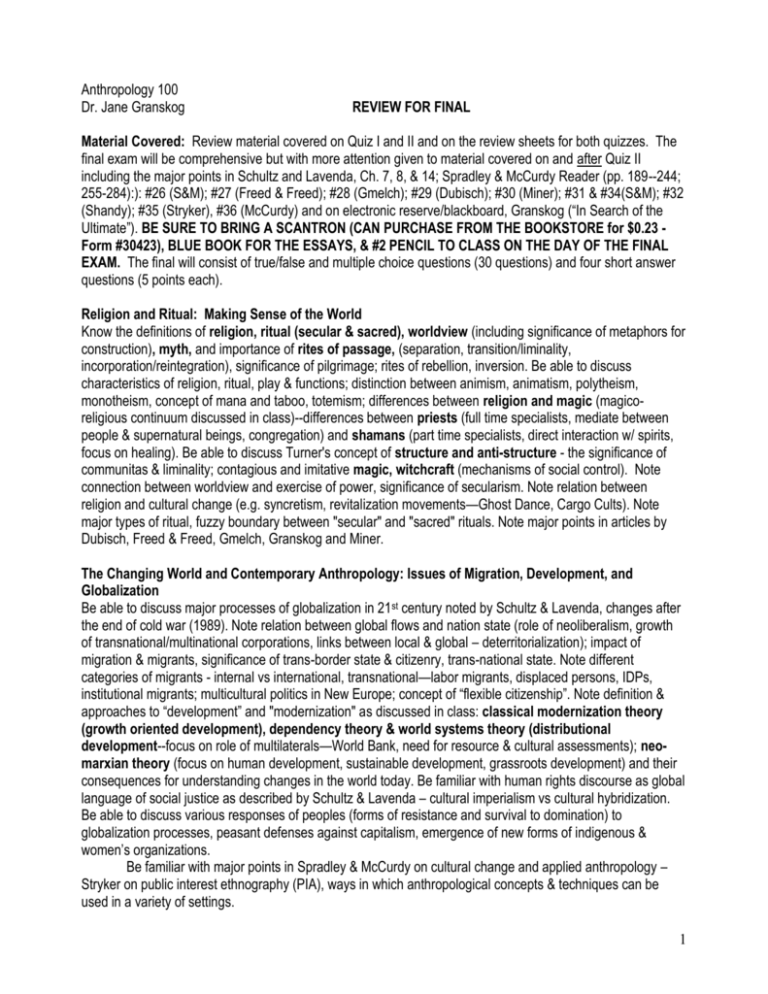
Anthropology 100 Dr. Jane Granskog REVIEW FOR FINAL Material Covered: Review material covered on Quiz I and II and on the review sheets for both quizzes. The final exam will be comprehensive but with more attention given to material covered on and after Quiz II including the major points in Schultz and Lavenda, Ch. 7, 8, & 14; Spradley & McCurdy Reader (pp. 189--244; 255-284):): #26 (S&M); #27 (Freed & Freed); #28 (Gmelch); #29 (Dubisch); #30 (Miner); #31 & #34(S&M); #32 (Shandy); #35 (Stryker), #36 (McCurdy) and on electronic reserve/blackboard, Granskog (“In Search of the Ultimate”). BE SURE TO BRING A SCANTRON (CAN PURCHASE FROM THE BOOKSTORE for $0.23 Form #30423), BLUE BOOK FOR THE ESSAYS, & #2 PENCIL TO CLASS ON THE DAY OF THE FINAL EXAM. The final will consist of true/false and multiple choice questions (30 questions) and four short answer questions (5 points each). Religion and Ritual: Making Sense of the World Know the definitions of religion, ritual (secular & sacred), worldview (including significance of metaphors for construction), myth, and importance of rites of passage, (separation, transition/liminality, incorporation/reintegration), significance of pilgrimage; rites of rebellion, inversion. Be able to discuss characteristics of religion, ritual, play & functions; distinction between animism, animatism, polytheism, monotheism, concept of mana and taboo, totemism; differences between religion and magic (magicoreligious continuum discussed in class)--differences between priests (full time specialists, mediate between people & supernatural beings, congregation) and shamans (part time specialists, direct interaction w/ spirits, focus on healing). Be able to discuss Turner's concept of structure and anti-structure - the significance of communitas & liminality; contagious and imitative magic, witchcraft (mechanisms of social control). Note connection between worldview and exercise of power, significance of secularism. Note relation between religion and cultural change (e.g. syncretism, revitalization movements—Ghost Dance, Cargo Cults). Note major types of ritual, fuzzy boundary between "secular" and "sacred" rituals. Note major points in articles by Dubisch, Freed & Freed, Gmelch, Granskog and Miner. The Changing World and Contemporary Anthropology: Issues of Migration, Development, and Globalization Be able to discuss major processes of globalization in 21st century noted by Schultz & Lavenda, changes after the end of cold war (1989). Note relation between global flows and nation state (role of neoliberalism, growth of transnational/multinational corporations, links between local & global – deterritorialization); impact of migration & migrants, significance of trans-border state & citizenry, trans-national state. Note different categories of migrants - internal vs international, transnational—labor migrants, displaced persons, IDPs, institutional migrants; multicultural politics in New Europe; concept of “flexible citizenship”. Note definition & approaches to “development” and "modernization" as discussed in class: classical modernization theory (growth oriented development), dependency theory & world systems theory (distributional development--focus on role of multilaterals—World Bank, need for resource & cultural assessments); neomarxian theory (focus on human development, sustainable development, grassroots development) and their consequences for understanding changes in the world today. Be familiar with human rights discourse as global language of social justice as described by Schultz & Lavenda – cultural imperialism vs cultural hybridization. Be able to discuss various responses of peoples (forms of resistance and survival to domination) to globalization processes, peasant defenses against capitalism, emergence of new forms of indigenous & women’s organizations. Be familiar with major points in Spradley & McCurdy on cultural change and applied anthropology – Stryker on public interest ethnography (PIA), ways in which anthropological concepts & techniques can be used in a variety of settings. 1 Sample Essay – Also review sample essays for Review I & II 1. Based on the readings in Schultz and Lavenda and the Spradley and McCurdy Reader as well as class discussions, how do you think research in cultural anthropology contributes to your understanding, and perhaps solving, social conflict? In your answer, consider examples of interpersonal conflict as well as larger-scale conflict. 2. What is meant by power? How do the views of power held in stateless societies differ from those in stratified state societies? How might these differences be related to the difference between synergic and directive power that we discussed in class? Finally, how might these different views of power impact the response of people in the developing world to globalization processes? In answering this last question, consider the following statement: "The power of the powerful rests upon acceptance of that power by the powerless." 3. What are the similarities and differences in the ways religious specialists in tribal societies (shamans) and religious specialists in the major organized religions (priests) communicate with the supernatural? What role, if any, might shamans play within our own society? Can shamanism function as a guide in complex societies such as our own to help us meet the challenge of rethinking our relation to the world around us? If so, how? 4. Under what conditions is magic most often employed? Give an example of how it is used. What does the use of magic tell us about the ways in which we may use ritual behavior to cope with our environment? Use examples from relevant readings (e.g., Gmelch, "Baseball Magic", Miner, the discussion in Schultz & Lavenda etc.) and class discussions to illustrate your points. 5. Indigenous people and women have been affected by international development and globalization processes in various ways, often negatively. Based on the readings in Spradley and McCurdy and Schultz & Lavenda, discuss the similarities and differences in the ways in which they have reacted to and dealt with the challenges presented by globalization. 6. What are some of the economic aspects of migration? In your answer, consider both motivations for migration and aspects of adaptation in the new location. Use examples from the various readings, the video “Invisible Indians”, class discussion and/or your own experience to support your argument. 7. In class and in Schultz & Lavenda, several major theoretical perspectives that anthropologists have used to try to explain the relationship between the West and the rest of the world were discussed. Briefly describe these different perspectives. In what ways are they alike? On what points do they differ? Which approach do you think holds the best hope for the future? Why? Cite examples from the readings to support your case. 2
